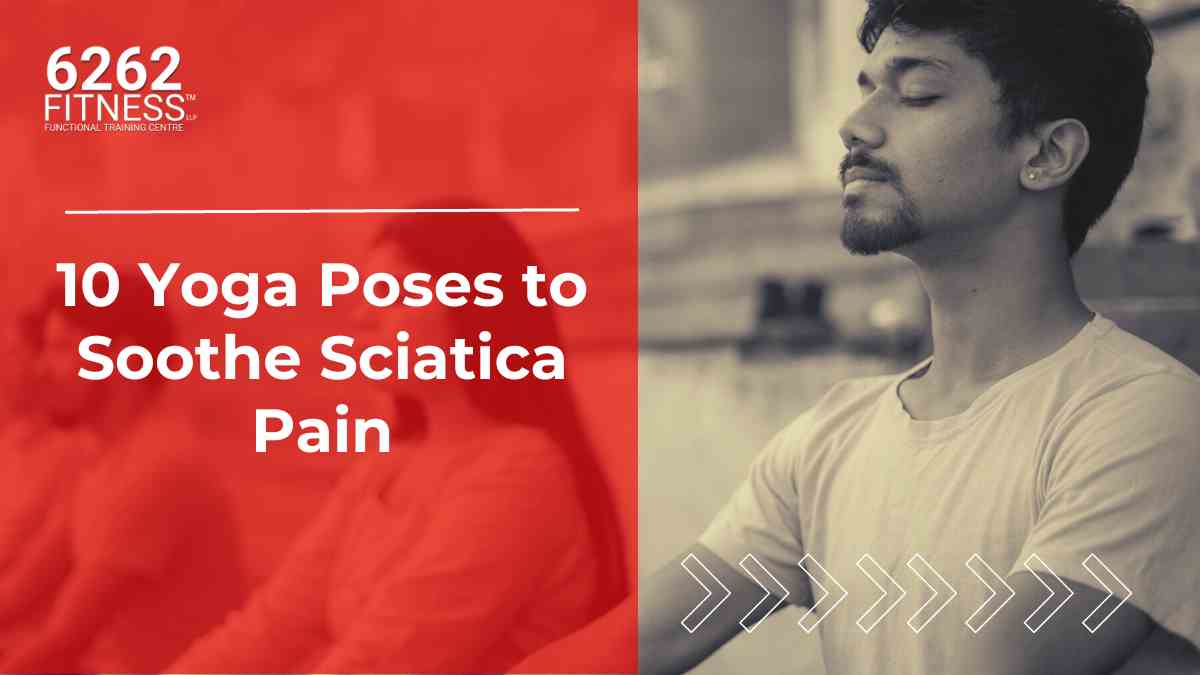
Sciatica is caused by injury, compression, or irritation of the lower vertebrae or sciatic nerve. Injured, tight, or overused muscles can also lead to sciatica. Sciatica pain is a throbbing, burning, or sharp sensation that radiates or shoots from your leg. You may also experience inflammation, numbness, and tingling sensation. Often you may feel sciatica pain on only one side of your body. In this blog, we’ll read about the symptoms of sciatica and 10 yoga poses for sciatica pain.
Certain studies have shown that yoga poses can help with relieving sciatica pain. Yoga poses like the Locust pose and Cobra pose can reduce severe lower back pain, improve mobility, and reduce the usage of pain medications.
Symptoms of Sciatica
Sciatica is pain and tenderness along the sciatic nerves which are found in our legs. These nerves originate from the nerve roots that exit from your spinal cord and then run through the apertures found in your sacrum. These nerves then merge to form the sciatic nerve which is the longest nerve found in your body.
This nerve passes through the layers of your deep buttock muscles (gluteus maximus and gluteus minimus), the muscles of your thigh’s back, and finally down through your leg’s outer edge to your foot.
Sciatica generally flares up while running, bending over, sitting, and any other everyday movements. Symptoms of sciatica include:
- Pain and tenderness anywhere along your sciatic nerve pathway: in the back of the thigh, lower back, calf, and/or buttocks
- Loss of feeling, numbness, and fatigue in your feet/or legs
- Weakness that can make your knees buckle when trying to stand up directly from sitting
- A pinching, tingling, electric, or burning feeling known as paresthesia
- Foot drop, a condition that disables you from flexing your ankles enough to try and walk on your heels
- Reduced reflexes in the knee and Achilles tendon
How to find the cause of your Sciatica
Doctors often look for a herniated disk in the patient’s lumbar spine when they complain of sciatica pain. If you are experiencing pain in the lower back, numbness in the feet or legs, burning or tingling sensation in the legs, and/or painful electric shocks in your sciatic nerve, you need to visit a doctor.
There can be several causes of experiencing sciatica pain including:
- Obesity
- Slipped disc
- Osteoarthritis
- Back injuries
- Narrowing of the spinal cord in your lower back
- Compressed nerve fibers
- Sitting and bending for hours
- Piriformis syndrome – The piriformis muscle in your rear region spasms or tightens, flaring up the sciatica muscle
How to tell if the pain is caused by the Piriformis
Here are a few indicators to understand if the pain originates in the piriformis:
- Pins-and-needles sensation and pain from the outside of your calf till the fourth and little toes
- Difficulty walking on your toes or your heels
- Burning sensation in the back of your calf and thigh down to your heels. You may also feel stiffness in your legs
- Pain from prolonged sitting supported by a tingling or burning sensation at the back of the thighs. The pain may be relieved after you stand but you may still feel some numbness in your toes
- Sciatic or buttock pain from sitting or exercising for long periods with or without any numbness, tingling, or weakness sensation. The pain may tend to get worse when you sit down.
How yoga can help relieve Sciatica pain
- Yoga poses can help straighten, strengthen, and align the lower back which is the source of your sciatic nerve
- Time and activity can tighten your hip muscles which creates pressure on your sciatic nerve. Certain yoga asanas help to loosen and lengthen these muscles
- Yoga asanas assist in lengthening the spine which in turn will relieve pain caused by the pressing of your spinal cord on your sciatic nerve
- Simple yoga stretches can ease the pain caused along your sciatic nerve
- Some spinal twists help to relieve pain caused by sciatic nerve compression
10 yoga poses to relieve Sciatica pain
Child’s Pose (Balasana)
Balasana stretches and lengthens your spine, promoting openness and flexibility in your thighs, lower back, and hips. Extend your arms in front of you, bring your knees together, and bring your hips to your heels. Take deep breaths and hold the pose for around 5 minutes. It is one of the best yoga pose for sciatica pain.
Downward-Facing Dog
This yoga pose aligns your body and relieves pain and tightness. It boosts your body’s strength and corrects imbalances. Start on your knees and hands and press into your hands when you lift your hips and drop down your head. Bend your knees and slightly tilt your pelvis forward. Hold the pose for about a minute.
Half Moon Pose (Ardha Chandrasana)
Ardha Chandrasana pose stabilizes, balances, and strengthens your body. It also relieves tension, boosts flexibility, and stretches your glutes, thighs, and spine. Stand in a triangle pose and keep your right foot in front. Lift your left leg parallelly to the floor and rotate your torso. Keep your right hand on the floor and bring your left hand up to the ceiling. Repeat on the opposite side.
Cobra Pose (Bhujangasana)
This pose stretches and strengthens your spine, promoting flexibility and circulation. Lie on your stomach, place your hands under your shoulders, and squeeze your elbow towards your body. Lift your shoulders, chest, and head while inhaling. Hold it for about 30 seconds.
Locust Pose (Salabhasana)
The Salabhasana pose strengthens your glutes, thighs, and spine. It stabilizes your lower back and core. It also boosts flexibility and circulation in your hips. Lie on your stomach and slowly lift your head, arms, and chest as high as you can. Bring your arms up towards the ceiling and raise your legs as well. Hold for about 30 seconds.
Wind-Relieving Pose (Pawanmuktasana)
This pose eases the tightness in your glutes, lower back, and hips. Lie on your back and bring your knees towards your chest. Lift your head and bring your chin to your chest. Hold the pose for about 1 minute.
Reclined Pigeon Pose (Supta Kapotasana)
The reclined pigeon pose stretches your hips, glutes, and piriformis muscles. Lie on your back and bend your knee to bring it toward your hips. Repeat the process on each side and hold for about 1 minute.
Bridge Pose (Setu Bandha Sarvangasana)
The bridge pose stretches and opens the hips flexors and strengthens the back muscles and core as well. It also reduces lower back pain.
To do this yoga pose, align your foot, thighs, and back in a straight line and hold it for about 10 seconds. Gradually increase the length of your pose.
Half Lord of the Fishes Pose (Ardha Matsyendrasana)
This pose lengthens and stretches your spine, relieving tension and pain. Be in a seated position and bring your left to the outside of the right hip with your knee pointed to the side or forward. Move your right foot to the outside of your left thigh. Bring the fingertips of your right hand to the floor behind you to support you.
Lengthen and lift your spine while inhaling and twist your body while exhaling. Repeat on each side and hold the pose for 1 minute every time.
Legs-Up-the-Wall Pose (Viparita Karani)
This yoga pose relieves tired feet and legs, relaxes the back and hip, and lessens ankle and knee pain. Sit down with your right side against the walk and slowly lie down with your legs up along the wall. Try to bring your hips closer to the wall and keep your arms in a comfortable position. Hold the pose for about 20 minutes.
The Takeaway
If you are experiencing sciatica pain, the above-mentioned yoga poses can help you feel better. Practice with safety, ease, and gentleness. For the best results, you can join yoga classes conducted by professionals. Moreover, visit a physical therapist or a doctor regularly to ensure that the yoga practice seasons are benefitting you.
Read more: Benefits Of Yoga For Mental Health


